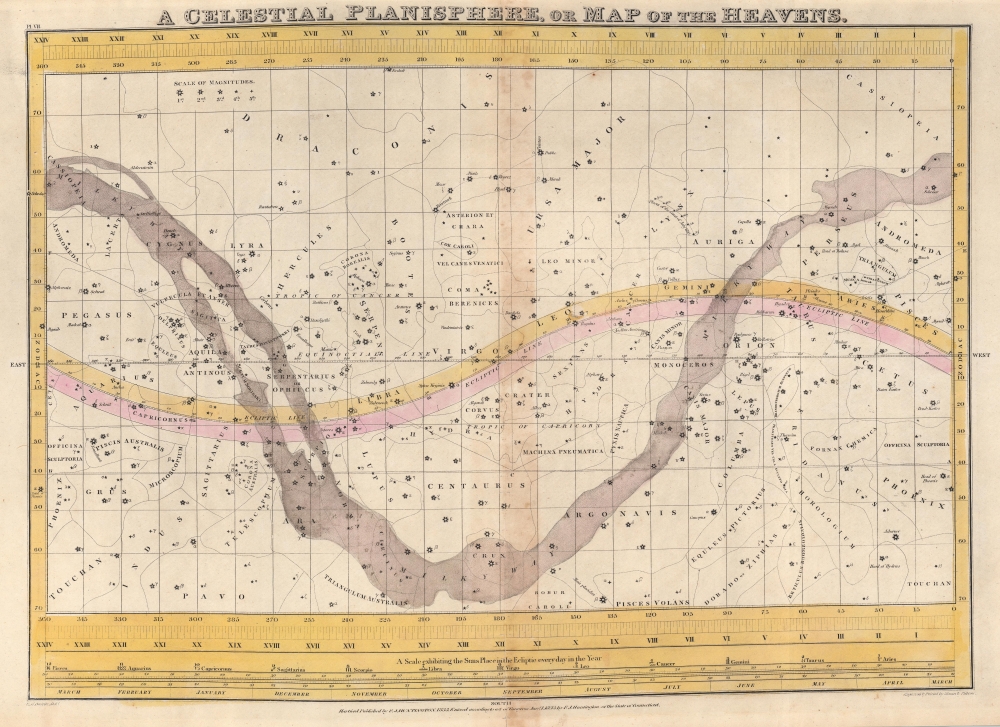1833 Burritt / Huntington Map of the Heavens or A Celestial Planisphere
Heavens-burritt-1833-2
Title
1833 (dated) 15.5 x 21.75 in (39.37 x 55.245 cm)
Description
Publication History
This map was engraved by W. G. Evans of New York under the direction of Elijah H. Burritt. It was issued as plate no. VII in the 1833 edition of F. J. Huntington's Atlas Designed to Illustrate the Geography of the Heavens. Dated and copyrighted: 'Hartford Published by F. J. Huntington 1833. Entered according to Act of Congress Sept. 1st, 1833 by F. J. Huntington of the State of Connecticut'.CartographerS
Elijah Hinsdale Burritt (April 20, 1794 - January 3, 1838) was an American astronomer and mathematician active in Connecticut. Burritt is often called 'the forgotten astronomer.' Burrito was born to an impoverished family and was initially apprenticed as a blacksmith. After an injury on the job, Burritt turned to astronomy with a passion. He studied at Williams Collage, from which he graduated in 1816. After graduation he moved to Milledgeville, then capital of Georgia. He taught at local schools for several years but, being a northerner, began to feel uncomfortable as his 'yankee attitudes' alienated his peers. He returned to Connecticut in 1829 and turned his parents home into an observatory to pursue his love of astronomy. Burritt then organized a group of 30 settlers to relocate to the newly formed Republic of Texas. There, Burritt and many of his fellow settlers contracted Yellow Fever and died. His seminal work, Burritt's Geography of the Heavens was published from Hartford, Connecticut, in approximately 1833. The work, while primarily educational in nature, was the seminal American geography of the period. Much of the nomenclature they developed, especially regarding the visible stars and constellations of the Southern Hemisphere, is still in use today. The atlas itself consisted of eight charts depicting the heavens seasonally and hemispherically. Constellations were depicted figurally, though only the most important stars were noted. The Geography of the Heavens was the last decorative celestial reference in the 19th century. Burrit's geography was among the most prized possessions of fantasy / horror writer H.P. Lovecraft who wrote:
"My maternal grandmother, who died when I was six, was a devoted lover of astronomy, having made that a specialty at Lapham Seminary, where she was educated; and though she never personally showed me the beauties of the skies, it is to her excellent but somewhat obsolete collection of astronomical books that I owe my affection for celestial science. Her copy of Burritt's Geography of the Heavens is today the most prized volume in my library." (to Maurice W. Moe, 1 January 1915)As a side note Elijah Burritt is the brother of the more famous Elihu Burritt, known for his philanthropic and social work. More by this mapmaker...
Francis Junius Huntington (December 3, 1802 - February 5, 1878) was an American publisher of books and later music. Born in Suffield, Connecticut, Huntington was the son of Hezekiah Huntington, who fought in the American Revolutionary War (1775 - 1783), worked as a prominent attorney in Connecticut after the war, and was appointed District Attorney for Connecticut by President Thomas Jefferson in 1806. Francis Huntington grew up in Hartford, Connecticut. He entered the publishing world in Hartford at a young age and soon found success in his chosen field as a bookseller, printer, and publisher. Atlases, geography books, and textbooks were among the many works he published. He moved to New York City in 1862 where he began publishing musical books. He died in New York in 1878. He married Stella Bradley Bull on September 1, 1833, with whom he had seven children, three of which died in childhood. Learn More...

